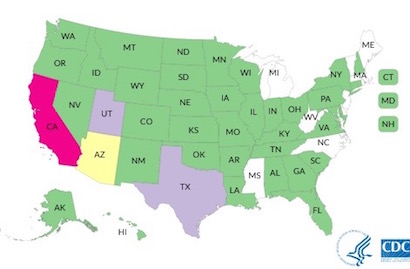The Centers for Disease Control and Prevention (CDC) has posted, stating that the Salmonella Poona outbreak linked to cucumbers imported from Mexico by Andrew & Williamson Fresh Produce is finally over. At least 907 people in 40 states were sickened by the outbreak strain. Six people died, and 204 were hospitalized.

The final case count by state is: Alabama (1), Alaska (21), Arizona (140), Arkansas (13), California (245), Colorado (21), Connecticut (1), Florida (1), Georgia (1), Hawaii (1), Idaho (27), Illinois (11), Indiana (5), Iowa (7), Kansas (2), Kentucky (1), Louisiana (5), Maryland (1), Minnesota (46), Missouri (15), Montana (16), Nebraska (8), Nevada (17), New Hampshire (1), New Mexico (37), New York (6), North Dakota (8), Ohio (3), Oklahoma (13), Oregon (23), Pennsylvania (3), South Carolina (10), South Dakota (3), Tennessee (1), Texas (51), Utah (62), Virginia (1), Washington (26), Wisconsin (46), and Wyoming (7). The six deaths were reported from Arizona (1), California (3), Oklahoma (1), and Texas (1). A Salmonella infection was not considered a contributing factor in two of the three California deaths.
Laboratory, epidemiologic, and traceback investigations identified cucumbers imported from Mexico and distributed by Andrew & Williamson Fresh Produce as the likely source of the illnesses in this outbreak. Two recalls of cucumbers were announced; one by Andrew & Williamson, the other by Custom Produce Sales.
The peak of the outbreak occurred in August and September 2015. There was another surge of illnesses reported in late 2015 and early 2016, even though the shelf life of the cucumbers is about 10 days and the vegetable should not have been available in grocery stores or restaurants. The Salmonella bacteria from those 127 sick persons suggested they shared a common source with the illnesses that occurred during the peak of the outbreak.
Public health officials interviewed 46 of those ill persons in the late group. Of that group, 29, or 63%, reported eating cucumbers the week before they got sick. Investigators could not determine if those later illnesses could be explained by cross-contamination in the distribution chain for the recalled cucumbers. Another food linked to the illnesses was not identified.
The PulseNet system was used to identify illnesses that were part of this outbreak. PulseNet performed DNA fingerprinting on the bacteria by using pulsed-field gel electrophoresis (PFGE) and whole genome sequencing (WGS).
Illnesses started on dates ranging from July 3, 2015 to February 29, 2016. The patient age range was from less than 1 year to 99 years, with a median age of 18. Forty-nine percent of all patient were children younger than 18 years.
Many of those sickened in this outbreak were interviewed. Of the 519 people interviewed, 391, or 75%, reported eating cucumbers before they got sick. That is significantly higher than results from a survey of healthy persons, where about 47% of those ate cucumbers the week before they were interviewed. In total, eleven illness clusters were identified in seven states. In all of those clusters, cucumbers were stated as a common item eaten by ill people.
There were 30 clinical isolates of Salmonella Poona bacteria collected from ill persons. Of those, 2 were drug resistant to one or more antibiotics. One drug-resistant isolate was resistant to tetracycline.
Testing of cucumbers collected from the Andrew & Williamson Fresh Produce facility in California isolated the outbreak strains of Salmonella Poona. And whole genome sequencing of Salmonella Poona isolated from patents and from cucumbers distributed by Andrew & Williamson found that the strains were closely related genetically.
The symptoms of a Salmonella infection include nausea, vomiting, abdominal pain, diarrhea that may be bloody, fever, chills, headache, and muscle pains. Symptoms usually appear six to seventy-two hours after exposure to the virus. The illness usually lasts about a week, and most people recover without medical treatment.
However, 204 people were hospitalized in this outbreak, which means their illnesses were severe. And Salmonella infections are underreported. Public health officials use a multiplier of 30.3 when estimating how many infections are actually in an outbreak. That means that at least 27,482 people may have been sickened in this particular outbreak.




